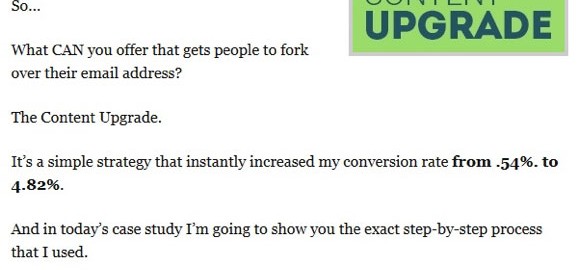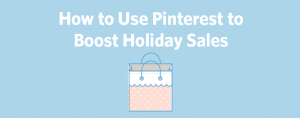One of the biggest reasons list building is so important is that you’re creating an ever-growing pool of views, comments, shares, and sales that can be tapped into at any time.
If you write an epic post today that goes semi-viral and receives 50,000 views, that’s amazing, but what happens next week when you write your next post? If you have a solid email capture system in place, you now have 5-10% of those views returning to read, share, comment, purchase, etc.
Plus, you have a valuable asset – a lead list you can pitch products and services too. If you know what you’re doing with email marketing, you can make a killing from an email list. And if you don’t, you can still do pretty well. Email subscribers convert like crazy.
But if you didn’t capture any of that traffic, you’re back to square one.
Don’t be that business. You work hard to get people to your site. Harness that traffic. It’s time to grow your list, and I’ve put together 21 powerful ways to do just that.
1. Write 2-Part Blog Series Instead of Single Posts
The way most lead capture works these days is a little box at the end of post saying something along the lines of “For regular tips and insights on _____ topic, signup to my newsletter” or “To get my best work sent straight to your inbox…” or “Enter your email to get instant access to ______ download.”
These sort of lead capture attempts can work fine, particularly if you are offering a compelling lead magnet (as we’ll discuss later), but they are rarely apples to apples with the article your visitor just read.
If you are creating amazing content, you can expect that a decent percentage of your visitors will read to the end (use SumoMe’s Content Analytics tool to track this stat), but once they get there you only guaranteed fact about them: they were interested enough to read to the end of the article.
Yeah, no kidding bro. But what does this tell us? It means if this article was longer, they probably would have kept reading to the end. Or another way to think about it is, if there was a Part 2, they would probably be interested in reading it.
After having this idea, I tried it out on a brand new blog that had around 300 subscribers. At the end of the first article, I announced that Part 2 would be up next week and invited readers to enter their email address if they’d like me to email them when it went live. The blog acquired 400 new email subscribers in that first week alone.

The best part about this strategy is it requires zero additional work. It’s similar to Content Upgrades (which we’ll discuss later) in some ways, but involves FAR less work. There’s no reason not to give it a shot and see if it works for your business.
2. Write Content Influencers Will Want To Share & Send It To Them
One of the things most people don’t realize is that while influencers have built their followings through providing targeted expertise, not all of that expertise is self-generated. A big part of building a following is partnering with other experts and sharing a variety of valuable resources from a variety of sources.
Influencers want to share really great content with their audiences. That’s a guarantee.
The first step to getting them to share your work is to create something that will be intriguing to them and valuable to their audience. In other words, you need to either produce content that is uniquely valuable or you need to redo existing content in a way that puts the original to shame.
Brian Dean used this strategy to build Backlinko to 100k visitors per month writing only one blog post per month. As he talks about here, the key was creating content that appealed more to influencers in his niche than even the audience he was targeting.
That’s the time consuming step, but the next step is the trickiest. You have to find away to get that content in front of those influencers. This is a nuanced process, but Brian again has us covered with these basic steps:
- Respond to their comments and questions on social channels.
- Leave insightful comments on their blog.
- Email them letting them know how much you love their writing.
- Point out broken links or other bugs when possible.
- Reach out with your content after you’ve made a connection
Influencer shares can be the difference between having an amazing blog no one ever sees and becoming the web’s next hot publisher. If you can connect with the tastemakers, you can become one yourself.
3. Ask Your Social Followers To Subscribe… Regularly
Email marketing converts at a significantly higher rate than social media, which is why email subscribers are significantly more valuable than social followers.
That said, if you have an existing social following, why not take advantage by asking your followers to subscribe? It’s easy, it costs you nothing, and it’s a great way to get a quick boost in your subscriber count. I was able to help one client land 5,000 new subscribers in one week using this technique alone.
The key here is to ask regularly rather than just once or twice. Most of your followers only see a fraction of your posts, and you should be getting new followers every day, so it makes sense to request subscriptions at regular intervals. If you can offer some sort of incentive or even just promise exclusive content within your emails, that helps too.
4. Create A Site-Wide Lead Magnet If You Haven’t Already
Having a lead magnet is old, OLD news and yet, so many sites today still simply ask for emails without offering anything in return.

WHY?
Creating a lead magnet is not hard. It can be as simple as taking your most popular post, adding a bit of content, and formatting it into a nice looking PDF. Or even better, follow Neil Patel’s Quick Spout model and break it into an 8-part email series, using each piece to build trust and establish expertise with your new subscribers.

The most important element of a high-converting lead magnet is that it solves an actual problem your target audience is thinking about. If you can provide a solution to the problems on their mind, you can quickly build a target list of email subscribers.
Lead magnets can take on any number of formats, including:
- Educational ebook, cheatsheet or blueprint
- Data-based report or market analysis
- Toolkit, swipe file or resource list
- Email or video training series
- Assessment, diagnostic or other interactive test
Creating a single lead magnet allows you to offer something to visitors anywhere on your site. It’s not the ideal lead capture scenario, but it’s far better than no lead magnet at all. For those looking to step up their lead magnet game, you’ll want to get a bit more segmented.
5. Create Lead Magnets For Each Topical Category
If you cover a number of different topics on your blog, having a single lead magnet isn’t ideal. A customer visiting to read about web design won’t necessarily have any interest in your “Advanced Guide To Inbound Marketing”.
Without creating a ton more work for yourself, you can create a far better lead capture system by offering a separate lead magnet for each topical category. For example, if you publish content on web design, inbound marketing and freelancing, you would create 3 different lead magnets:
- Web Designer’s Must-Have Resource Kit – offered on every web design blog post
- Advanced Guide To Inbound Marketing – offered on every marketing blog post
- The 10-Step Blueprint To 6-Figure Freelancing – offered on every freelance blog post
HubSpot does a great job of this, although with 7 separate blogs and countless covered topics, they go significantly overboard. Accordingly, they’ve created hundreds of resources that can be used as lead magnets:

HubSpot will then match a relevant resource to most of the 30+ blog posts they post every day, giving nearly every post a targeted lead magnet. While the numbers here probably aren’t relevant to your business, think of it this way. HubSpot is publishing nearly 12,000 articles per month with around 200 available lead magnets. That’s just 1 lead magnet per 60 posts. You could easily make 1 lead magnet per 60 posts. That’s the same as posting once per week for a year and then repurposing the best of that content into an ebook.
The point here is that if you are willing to do a little extra work, you can offer every visitor landing on your blog a relevant, targeted lead magnet instead of a generic site-wide offer.
6. Use Content Upgrades For 10x Performance On Your Blog Posts
So we started with a site-wide lead magnet. Then we upgraded to per-category lead magnets. Now, if you want to take the final step towards optimizing your per-post list building, we have content upgrades.
A Content Upgrade is a lead magnets created specifically for a single post. It typically involves a good deal more work than the category option we just discussed, but if your content strategy involves higher quality content published less frequently, it’s an amazing way to get the absolutely most out of your posts.
Bryan Harris from Video Fruit used this strategy to increase his subscription rate to 30% per upgrade offer. His best offers have generated an insane 62% subscription rate.

Brian Dean of Backlinko catapulted his subscriptions by 785% with this strategy. Authority Hacker used a single content upgrade to collect over 11,000 emails.

This strategy gets unrivaled results, but it can also be one of the most time consuming strategies. To cut down on time, check out this guide for content upgrades you can create in just 30 minutes.
7. Create Free Tools For Your Target Audience
Unlike some will tell you these days, content-based lead magnets are never going to stop working. Sure, uninteresting, repetitive ebooks may not cut it anymore, but the problem is in the execution rather than the medium. People will always want access to the insights and strategies of those with more experience and greater success.
That said, in an age where tens of thousands of websites are offering content-based lead magnets, you will almost never generate any buzz with a content-based lead magnet. Ebooks are just old news. Checklists, blueprints, and market reports are nothing to write home about. People interested in the topic will absolutely download it, but they probably aren’t going to get excited and tell everyone they know about it.
And this is why creating a free tool as your lead magnet can be so effective. Sites like Pingdom and Buzzsumo have become go-to stops for businesses looking to get a quick overview of site speed or social buzz respectively. Every time visitors use the free tool, they are reminded of how much more data will be available when they upgrade to premium.

SumoMe has built its entire business model on this concept, offering an entire suite of free tools and grabbing over 300,000 users as a result. Free users are presented with the option to upgrade to premium every few times they login and are presented with success stories via email.
Creating some an online tool gives people something tangible to get excited about and share with their friends, coworkers and acquaintances. And while it’s not going to be the right investment for every business, it could be a big win for yours.
8. Use Incentivized Referrals To Turn Customers Into Evangelists
Like tool creation, referrals can score MASSIVE wins for the right business models. If you can motivate your customers to spread your brand, you are in for exponential growth in a very short period of time.
People love to share cool stuff. They love to let their friends in on great opportunities, particularly when there is an upside for them personally.
After seeing weak results using Google Adword, Dropbox implemented a referral system that drove 4 million signups in 15 months. How? By offering meaningful incentives to both the referrer and the friend being referred.

Two-way incentives are a great way to put your referrals system into overdrive and generate quick growth. Here’s a how-to guide by Sacha Greif on setting up a simple DIY email referral system.
9. Host A Giveaway To Quickly Scale Your Audience
Giveaways are a fantastic way to engage people with your brand and build your email list.
When the marketing team at WWRD ran a sweepstake in 2011, it increased email subscribers by an impressive 11%. Perhaps even more importantly, customers obtained via the giveaway had a 21.7% higher order value than the site-wide average.
Bryan Harris used a giveaway to land 2,239 emails in 10 days. Josh Earl acquired over 60,000 emails with a giveaway in the same amount of time.
Giveaways are a sure-fire strategy when run correctly. In order to be successful, you need to make sure to include the following components:
- A compelling prize your audience actually wants
- Bonus entries given for referred entrants (can use KingSumo Giveaways plugin)
- Guaranteed bonus incentives for all non-winners (something you can give at no cost)
- Major promotion to relevant audiences
The biggest problem with most giveaways is that they pick up a ton of non-relevant subscribers who won’t ever be interested in your product. The solution to this is to offer a prize that will ONLY interest your target audience.
For example, in the Bryan Harris giveaway I mentioned earlier, the prize was a 10 year subscription to Leadpages, an industry-leading landing-page service. For someone in Bryan’s target audience – online marketers – that’s a $ 3,000 value and an amazing prize. For anyone else (anyone not interested in marketing), it’s essentially worthless.

If you run them correctly, giveaways are a surefire way to quickly boost your email list. In addition to the direct benefit of more subscribers, giveaways also increase goodwill with existing subscribers, as you are giving them something free whether they win or not.
10. Run A Contest To Attract Engaged Customers
While a giveaway is a fantastic way to grab a ton of emails in your target market, it doesn’t necessarily engage people with your brand. You have to do that via the email marketing that comes next, and that’s completely fine for most businesses.
For certain markets, however, running a contest can provide you with an exceptional opportunity to directly engage with our audience and add the type of users to your list who can become brand evangelists. You might not get as many email subscribers as a giveaway, but you will get powerful mixture of highly-engaged subscribers and general brand awareness.
Successful contests are all about audience interaction. How can you get your users to participate with your brand? For Eggo, that looked like asking users to submit their favorite waffle recipes (with photos) for a cash prize of $ 5,000 to the winning entrant.

As part of this contest, Eggo collected the emails of numerous entrants willing to take the time to send them a recipe. While they acquired less emails than they might have with a giveaway, the emails they received involved users who were willing to engage directly with brand – an incredibly valuable segment!
The second part of the contest involved listing the recipes for public voting. At $ 5,000, the prize was compelling enough to motivate entrants to share with their friends and family, driving traffic to Eggo’s site and raising brand awareness. To collect even more emails, Eggo could have included an exclusive discount offer for incoming voters.
Contests are better than perhaps any other strategy on this list for generating direct engagement with your brand while building an audience of highly engaged fans. And at the end of a contest, you are left with tons of user-generated content that can be repurposed however you desire.
11. Include In-Email Sharing Options
One of the things I’m always looking for as a marketer is simple, one-off tweaks I can make to boost ROI. These types of adjustments may not make or break a campaign, but since they have no opportunity cost, they are always a big win.
In-email sharing is one of these tweaks. It takes two seconds to set up on email services like GetResponse and it can have a major impact on your click-throughs. According to this GetResponse study, emails with social sharing options have a 158% higher click-through rate (CTR) on average than emails that do not.

Like any marketing technique, this strategy performs better for certain industries than others. GetResponse’s data indicates that topics suitable for LinkedIn recieve the most in-email shares, suggesting that audiences interested in career, marketing, self-improvement, leadership, freelancing, market trends, etc. might respond best to this technique.

Regardless of your topic, however, the data suggests that including sharing options within your newsletter can only help your CTR. Give it a try and let us know what happens!
12. Utilize Popups & Slide-Ins To Capture Visitors
Popups and their slide-in counterparts work. That’s about all I can tell you. If you don’t believe me, believe everyone else who has published a case study on this phenomenon.
Social Media Examiner attributes 70% of its 190,000 subscriptions to the site’s pop-up form. Chris Penn’s subscriptions “fell off a cliff” after removing his site’s pop-up form.

Darren Rowse increased subscribers from 40 a day to 350 ater putting a pop-up subscription box on ProBlogger.net.

Popups are incredibly easy to implement and there are a host of free and low-cost premium options these days. Whether you want something simple or something immaculate, you can be up and running in a few minutes.
It doesn’t matter what niche or market you call home, popups work. Crafting blogger Nikki McGonigal increased her subscription rate from 0.4% to 5.5% with her lightbox pop-up, an increase of 1,375%!
I personally use SumoMe List Builder for pop-ups on a variety of blogs spanning across multiple niches. I used it on my men’s blog with astonishing results. Look at the chart below and guess when I installed popups.

For another blog in the progressive Christian niche, I tried a combination of SumoMe’s premium popups tool, a 2-part blog series, and content upgrades using forms from ConvertKit, and I was able to increase email subscribers by over 600 with just 2 blog posts.
If you aren’t using popups, you need to start.
13. Install Full-Page Dropdowns For Higher Conversions
Similar in function to a full-page popup, dropdowns are a more recent innovation, popularized by SumoMe’s Welcome Mat.
The idea behind the fullpage dropdown is to quickly add an above-the-fold email optin to any web page. As a general “best practice”, CTAs that are shown above the fold convert best, so being able to quickly add, test, and adjust a temporary “hero shot” (initial screenshot visitors see) is something worth trying.

Inbound.org had a question posted recently about the performance of these pages, and several marketers, including myself, had found success using these dropdowns on select pages. More specifically, we found that including them on natural “next step” pages increased conversion rates significantly.
In other words, asking people for something as soon as they land on your page is annoying and a bit assuming. The goal of lead capture is to invite people who like what you’re doing to come back. This is why I set my popups to show up between 20-40 seconds after a visitor has arrived. If a visitor has been reading your content for more than 20 seconds, he or she is interested in what you’re saying and probably intrigued to know who you are.
If they are so intrigued as to select another page to visit on your site, they are ready to be invited to your list. Accordingly, the marketers at Inbound.org, as well as myself, found that adding a dropdown to the homepage and blog feed page increased signups by around 200% as compare to normal popup performance.
14. Add Social Proof To Everything
When it comes to any form of conversion optimization, social proof is one of the more powerful ways to boost conversions. People like to join in things that are already popular and they are TERRIFIED of “missing out”. Social proof is so powerful, it’s kickstarted an entirely new brand of ecommerce called social commerce, where stores and social networks partner together to create an almost communal shopping experience.
According to Search Engine Journal, 63% of consumers say they are more likely to purchase from a site that has product ratings or reviews. In a series of peer-reviewed studies conducted in 2008, researchers determined that social proof had more of an effect on behavior modification than concepts like protecting the environment, personal responsibility or even saving money.
Guys like Michael Hyatt use social proof to demonstrate expertise and thought leadership. It’s a core piece of the “Build Your Platform” WordPress template he sells.
Look at that number in the top right corner of this image. Total Subscribers = 512,944. Wow.
That’s impressive. I don’t even know what it means, but it’s impressive. Does Michael Hyatt have 500k email subscribers? Not a chance. This number is probably a sum of his email subscribers, Twitter followers (241k), Facebook fans (57k), etc.
But when you land on that page as a new visitor, you don’t know what the number means. You just know that it’s impressive and you immediately start taking this guy seriously. That’s the power of social proof, and it’s as simple as adding the most impressive numbers you can spin next to your email optin or including a few reviews and testimonials on your sales and checkout pages.
15. Use Guest Blogging For The Correct Reasons
Outside of social shares, guest blogging is one of several accessible ways to get your content in front of other audiences. Guest blogging offers a number of powerful upsides, but it’s also somewhat misunderstood in the blogging world.
A lot of people think that guest blogs will result in direct traffic to your site, and while yes, you will get some direct traffic, I can tell you after writing over 100 guest posts that the time investment is not worth the amount of traffic you can expect to receive from even high traffic blogs.
Here’s why guest blogging is valuable:
- Get your name and most compelling thoughts in front of a much larger audience
- Get highly relevant backlinks to your website
- Make valuable connections with editors, webmasters, and publications in your industry
- Get direct traffic to your best landing pages
A lot of people think that you can simply throw up guest blogs on popular sites and the traffic will come rushing in through their author bio links. This couldn’t’ be further from the truth. Guest blogs can build your email list, but you’ll need the ability to publish them in a specific way.
If you want your guest blog to drive email subscribers, you’ll need to essentially pitch a lead magnet within the post itself. Mention your lead magnet at the beginning of the post and then directly pitch it and link to it at the end.
Bryan Harris used this strategy to grab 600 emails subscribers from this guest post on Jon Acuff’s blog. Compare those results to a blog post like this one, posted to Jon Morrow’s more popular website Boost Blog Traffic. This post received over 200 comments and 500 shares in the first few weeks but only drove 40 subscribers for the author, Kevin Duncan.
Why? Because you can’t get meaningful direct traffic from an author byline. Kevin even included an audience-specific link and offer in his byline, and it still wasn’t enough.

If you want to get a worthwhile number of subscribers from you guest posts, you have to post on a website that will let you include a direct CTA within the article itself.
16. Cross-Promotion Is A Guaranteed Win
Cross promotion is similar to guest posting in that you are leveraging another site’s audience. Unlike guest blogging, however, the goal here is to partner up with another website around your same size or a bit larger, giving you a guaranteed win.
For example, if your site has around 5,000 email subscribers, you might look to run a cross-promotion campaign with another site that has between 4,500 – 7,000 subscribers. When pitching a cross-promotion campaign, try to target audiences that are a bit larger than yours by highlighting your most impressive follower metrics.
Cross-promotion can look like anything. It can be as creative as you are. Here are a few ideas to get you started.
- Exchange guest posts using the format described in section #15
- Feature each other’s sites in social media posts or subscriber emails
- Partner with each other on product launches or giveaways
- Share each other’s content across social feeds
- Offer each other’s audiences discounts on products
There’s really no limit to what you can do. The key is to make sure that the cross-promotion method you select actually builds your audience and grows your list
17. Publish Insightful, Educational Case Studies
Case studies are a fantastic way to promote your business while attracting shares and backlinks. People love to read real stories and see real results. Anyone can post theories, but if you can show some repeatable results, you can establish yourself as a legitimate player in your sphere.
Many of the businesses I see publishing case studies are doing it all wrong. Success metrics are vague, informative content is limited, and 3/4ths of the post looks like a sales pitch. This is NOT the way to run a case study.
A case study designed to build your list will do 3 things:
- Fully explain the problem, hypothesis, process, and solution
- Summarize key observations and takeaways
- Act as as educational rather than promotional content.
You don’t need to promote your service in a case study. The study does it for you. If you can include your case study in a strategy guide for getting similar results, that can be even more effective. Brian Dean built Backlinko posting case study packed guides once per month for just over a year.
Not only will people be happy to share and link to an insightful case study when it goes live, but you’ll also continue grabbing backlinks long into the future. Think about. What types of links have I included in this post? What types of links to all marketing writers look for when proving their point in published articles?
Case studies. We link to case studies. If you have a bunch of insightful, SEO-optimized case studies on your blog, you’ll begin seeing pingbacks all over the place. It’s a no-brainer!
18. Host Webinars For Higher ROI
Webinars are essentially the same as other types of informative content, with three key exceptions:
- Viewers give you their email address BEFORE seeing the content.
- Webinars are really, really popular right now.
- Some people are much better at recording themselves speaking than they are at writing
Webinars allow you to grab a list of email addresses based on your headline value proposition alone. This means that, while you still have to deliver some good content, the pressure to WOW people into subscribing is not there.
Furthermore, many brilliant marketers are not that great at writing but can easily talk about key concepts for hours on end. Whereas it might take them 20 hours to write a world-class guide to email marketing, they could deliver an exceptional webinar on the same topic in just 30 minutes.
Lastly, webinars are everywhere right now, and if there’s one thing we know about marketing, it’s that if EVERYONE is doing it, it probably is generating a nice ROI. KISSmetrics reports grabbing an average of $ 13,000 in qualified new leads with each webinar.

With results like that, it’s no wonder webinars are all the rage these days. And while few businesses will cite their webinar numbers, the fact that virtually every other sidebar these days is promoting an upcoming webinar tells the tale.
19. Paid Advertising Is The Ultimate Way To Scale
Your first thought when it comes to listbuilding might not be to pay for new subscribers, but the reality is that any strategy you enact has a cost.
It costs money to get well-written articles. It costs money and time to host webinars. It costs money to run a giveaway or create a lead magnet. Everything has a cost, and that cost can be broken down to the number of subscribers you gain from it.
So at the end of the day, if you can use paid advertising to acquire subscribers at a lower cost-per-subscriber than any other method, it’s the best list building strategy for your business.
With the right content, I’ve been able to pay around $ 1 per subscriber using Facebook ads. Bryan Harris was able to get around $ 1.99 per subscriber for his highly profitable email marketing list.

The key to making paid advertising work is to scale slowly. Try multiple ads, eliminate the losers and scale the winners. And if you find something that is working, repeat mercilessly until it stops working.
20. Offer Subscriber Discounts In Exchange For Emails
Offering discounts or free items as a type of lead magnet is the ideal list building technique for ecommerce stores. Visitors will typically land on your store with intent to buy, so encouraging them with a discount is usually very effective.
Yandy.com is a perfect example of this. As soon as you land on a store page, you are greeted with a popup offering a free item in exchange for your email.

WOD Superstore users this method as well, offering a 3% discount in exchange for the visitor’s email address. While this isn’t a big discount, it’s better than nothing and there’s typically no reason for a visitor to say know if he or she is thinking about making a purchase.

While many businesses will offer discounts, few think about the opportunity to use those discounts as a list-building tool. It’s definitely something worth trying on your website.
21. Collect Emails At Offline Events
As shocking as this may sound, there are times when your online profit can come from offline activities! Events like conferences, trade shows, and seminars are a great place to connect with people in your market and are often a part of your calendar anyway.
These events are perfect opportunities for list building. You are interacting with not only people in your niche, but motivated people – people who were willing to pause their lives and maybe even travel an extended distance just to be there. Depending on the nature of the event, these individuals might be primed leads for your business.
Just as with collecting emails online, the key is to either find a way to collect emails en-masse or offer something valuable in exchange for direct interpersonal email subscriptions. If you are going to be speaking or communicating in any way, that’s a great opportunity to make your offer.
Conferences tend to be about learning, so think educational, particular in the vein of trend reports or market analysis. People want to learn, so you just have to make yourself a source of learning.
Conclusion
Building an email list doesn’t have to be hard. Use these methods to quickly scale your list and grow your audience.
Remember that getting subscribers is the easiest part of email marketing. It’s what you do with those subscribers afterward that really counts. Try to ensure continuous quality and relevance from the moment they open your lead magnet, through the sale, and beyond.
Your list will be a permanent, ever-growing asset for your business if you use it correctly.
Digital & Social Articles on Business 2 Community(131)
Report Post






